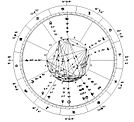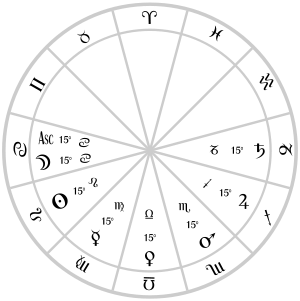- Classical planet
-
For the failed IAU planet category of Classical planets, see 2006 definition of planet.
Astrology Background History of astrology Astrology & astronomy Sidereal vs. Tropical Traditions Babylonian · Hellenistic Islamic · Western Hindu · Chinese More... Branches Natal astrology Electional astrology Horary astrology Mundane astrology More... Categories Astrologers Organizations Astrological texts Astrological writers Astrology Portal In antiquity the classical planets were the non-fixed objects visible in the sky, known to various ancient cultures. The classical planets were therefore the Sun and Moon and the five non-earth planets of our solar system closest to the sun (and closest to the Earth); all easily visible without a telescope. They are Mercury, Venus, Mars, Jupiter, and Saturn. The name planet comes from the Greek term πλανήτης, planētēs, meaning "wanderer", as ancient astronomers noted how certain lights moved across the sky with the other stars. They called these objects asteres planetai, or wandering stars. Together they form the seven classical planets, as well as the names of the seven days of the week - Sun-day, Moon-day, Saturn-day, and in Latin, 'Martis' (Mars, Tuesday), 'Mercurii' (Wednesday), 'Iovis' (Jupiter, Thursday) and 'Veneris' (Venus, Friday).
Mercury and Venus are only visible in twilight hours as their orbits are interior to the Earth's orbit. The third brightest object in the sky, Venus is the most prominent planet. Mercury is more difficult to see due to its proximity to the Sun. Lengthy twilight and an extremely low angle at maximum elongations make optical filters necessary to see Mercury from extreme northerly locations like Scandinavia or Alaska.[1] Mars is at its brightest when it is in opposition, which occurs approximately every twenty-five Earth-months. Jupiter and Saturn are the largest of the five planets, but are farther from the sun, and therefore receive less sunlight. Nonetheless, Jupiter is often the next brightest object in the sky after Venus. Saturn's luminosity is often enhanced by its rings, which reflect light back toward the Earth to varying degrees depending on their inclination to the ecliptic; however, the rings themselves are not visible to the naked eye from the Earth. Uranus and sometimes the asteroid Vesta are visible to the naked eye in principle on very clear nights, but unlike the true naked-eye planets they are always less luminous than several thousands of stars, and as such, do not stand out enough for their existences to be noticed without the aid of a telescope.
Contents
History
Babylonian astronomy
Babylonians grouped the stars in companies of seven. References are made to the seven Tikshi, the seven Lumashi, and the seven Mashi, which are older than the signs of the Zodiac; so far as can be ascertained these groups were selected from various constellations. When the five planets were identified, they were associated with the Sun and Moon and connected with the chief gods of the Hammurabi pantheon. A bilingual list in the British Museum arranges the sevenfold planetary group in the following order: [2]
Sumerian Akkadian planet godship Aku Sin Moon Sin/Suen Bišebi Šamaš Sun Šamaš Dapinu Umun-sig-êa Jupiter Marduk/Amarutu Zib/Zig Dele-bat Venus Ištar Lu-lim Lu-bat-sag-uš Saturn Ninib/Nirig/Ninip[3] Bibbu Lubat-gud Mercury Nabu/Nebo Simutu Muštabarru Mars Nergal Greek astrology
Symbols
Symbols for the classical planets, zodiac signs, aspects, lots, and the lunar nodes appear in the medieval Byzantine codices in which many ancient horoscopes were preserved.[4] In the original papyri of these Greek horoscopes, there are found a circle with one ray (
 ) for the Sun and a crescent for the Moon.[5] The written symbols for Mercury, Venus, Jupiter, and Saturn have been traced to forms found in late Greek papyri.[6] The symbols for Jupiter and Saturn are identified as monograms of the initial letters of the corresponding Greek names, and the symbol for Mercury is a stylized caduceus.[6] A. S. D. Maunder finds antecedents of the planetary symbols in earlier sources, used to represent the gods associated with the classical planets. Bianchini's planisphere, produced in the 2nd century,[7] shows Greek personifications of planetary gods charged with early versions of the planetary symbols: Mercury has a caduceus; Venus has, attached to her necklace, a cord connected to another necklace; Mars, a spear; Jupiter, a staff; Saturn, a scythe; the Sun, a circlet with rays radiating from it; and the Moon, a headdress with a crescent attached.[8] A diagram in Johannes Kamateros' 12th century Compendium of Astrology shows the Sun represented by the circle with a ray, Jupiter by the letter zeta (the initial of Zeus, Jupiter's counterpart in Greek mythology), Mars by a shield crossed by a spear, and the remaining classical planets by symbols resembling the modern ones, without the cross-mark seen in modern versions of the symbols.[8] The modern sun symbol, pictured as a circle with a dot (☉), first appeared in the Renaissance.[5]
) for the Sun and a crescent for the Moon.[5] The written symbols for Mercury, Venus, Jupiter, and Saturn have been traced to forms found in late Greek papyri.[6] The symbols for Jupiter and Saturn are identified as monograms of the initial letters of the corresponding Greek names, and the symbol for Mercury is a stylized caduceus.[6] A. S. D. Maunder finds antecedents of the planetary symbols in earlier sources, used to represent the gods associated with the classical planets. Bianchini's planisphere, produced in the 2nd century,[7] shows Greek personifications of planetary gods charged with early versions of the planetary symbols: Mercury has a caduceus; Venus has, attached to her necklace, a cord connected to another necklace; Mars, a spear; Jupiter, a staff; Saturn, a scythe; the Sun, a circlet with rays radiating from it; and the Moon, a headdress with a crescent attached.[8] A diagram in Johannes Kamateros' 12th century Compendium of Astrology shows the Sun represented by the circle with a ray, Jupiter by the letter zeta (the initial of Zeus, Jupiter's counterpart in Greek mythology), Mars by a shield crossed by a spear, and the remaining classical planets by symbols resembling the modern ones, without the cross-mark seen in modern versions of the symbols.[8] The modern sun symbol, pictured as a circle with a dot (☉), first appeared in the Renaissance.[5]Week-day names
Main article: Week-day namesThe Ptolemaic system used in Greek astronomy placed the planets in order, closest to Earth to furthest, as the Moon, Mercury, Venus, Sun, Mars, Jupiter, and Saturn. In addition the day was divided into 7-hour intervals, each ruled by one of the planets.
The first hour of each day was named after the ruling planet, giving rise to the names and order of the Roman seven-day week. Modern Latin-based cultures, in general, directly inherited the days of the week from the Romans and they were named after the classical planets—for example in Spanish Miércoles = Mercury, in French Mardi = Mars.
The modern English days of the week were inherited from gods of the old Germanic Norse culture—Thursday = Thor (Jupiter), Friday = Frige (Venus). It can be correlated that the Norse gods were attributed to each Roman planets and its god, probably due to Roman influence rather than coincidentally by the naming of the planets.
Alchemy
In alchemy, each classical planet (Moon, Mercury, Venus, Sun, Mars, Jupiter and Saturn) was associated with one of the seven metals known to the classical world (silver, mercury/quicksilver, copper, gold, iron, tin and lead respectively). As a result the alchemical glyphs for the metal and associated planet coincide. Alchemists believed the other elemental metals were variants of these seven (e.g. zinc was known as "Indian tin" or "mock silver" [9]).
-
☿ The symbol has been used since ancient times to represent both the element quicksilver (mercury) and the planet Mercury.
Some alchemists (e.g. Paracelsus) adopted the Hermetic Qabalah assignment between the vital organs and the planets as follows [9]:
Planet Organ Sun Heart Moon Brain Mercury Lungs Venus Kidneys Mars Gall bladder Jupiter Liver Saturn Spleen Western astrology
Planet Domicile sign(s) Detriment sign(s) Exaltation sign Fall sign Joy sign(s) Sun Leo Aquarius Aries Libra Sagittarius Moon Cancer Capricorn Taurus Capricorn Pisces Mercury Gemini (diurnal) and Virgo (nocturnal) Sagittarius (diurnal) and Pisces (nocturnal) Virgo Pisces Aries , Scorpio, Capricorn and Aquarius Venus Libra (diurnal) and Taurus (nocturnal) Aries (diurnal) and Scorpio (nocturnal) Pisces Virgo Gemini, Cancer and Aquarius Mars Aries (diurnal) and Scorpio (nocturnal) Libra (diurnal) and Taurus (nocturnal) Capricorn Cancer Leo, Virgo and Sagittarius Jupiter Sagittarius (diurnal) and Pisces (nocturnal) Gemini (diurnal) and Virgo (nocturnal) Cancer Capricorn Taurus, Leo and Libra Saturn Aquarius (diurnal) and Capricorn (nocturnal) Leo (diurnal) and Cancer (nocturnal) Libra Aries Gemini, Virgo and Scorpio Indian astrology
Indian astronomy and astrology (Jyotiṣa) recognises seven visible planets (including the sun and moon) and two additional invisible planets.
Sanskrit Name English Name Guna Represents Day Surya (सूर्य) Sun Sattva Soul, king, highly placed persons, father. Sunday Chandra (चंद्र) Moon Sattva Mind, queen, mother. Monday Mangala (मंगल) Mars Tamas energetic action, confidence and ego Tuesday Budha (बुध) Mercury Rajas Communication and analysis Wednesday Brihaspati (बृहस्पति) Jupiter Sattva the great teacher Thursday Shukra (शुक्र) Venus Rajas wealth, pleasure and reproduction Friday Shani (शनि) Saturn Tamas learning the hard way. Career and Longevity Saturday Rahu (राहु) Ascending/North Lunar Node Tamas a Asura who does his best to plunge any area of one's life he controls into chaos none Ketu (केतु) Descending/South Lunar Node Tamas supernatural influences none East Asia
For the five true planets, their element's Chinese character, hanzi(汉字), is also part of the names of weekdays in Japanese and Korean, complemented with Sunday and Monday.[10] However, Chinese and Vietnamese number the days other than Sunday.[11]
English Name Associated element Chinese/Japanese Characters Chinese pinyin Japanese romaji Korean Name Vietnamese Name Old astronomical names[12] Mercury water 水星 Shuǐxīng Suisei 수성 (Suseong) Sao Thủy Chénxīng (辰星) Venus metal/gold 金星 Jīnxīng Kinsei 금성 (Geumseong) Sao Kim, also "Sao Mai" as "morning star" and "Sao Hôm" as "evening star" Tàibái (太白) Mars fire 火星 Huǒxīng Kasei 화성 (Hwaseong) Sao Hỏa Yínghuò (熒惑) Jupiter wood 木星 Mùxīng Mokusei 목성 (Mokseong) Sao Mộc Suì (歲) Saturn earth 土星 Tǔxīng Dosei 토성 (Toseong) Sao Thổ Zhènxīng (鎮星) The cycles of the Chinese calendar are linked to the orbit of Jupiter, there being 12 sacred beasts in the Chinese dodecannualar geomantic and astrological cycle, and 12 years in the orbit of Jupiter.
See also
- Antikythera mechanism
- Aspects of Venus
- Definition of planet
- Five elements (Chinese philosophy)
- Geocentric model
- Celestial spheres
References
- ^ Sky Publishing - Latitude Is Everything
- ^ Mackenzie, Myths of Babylonia and Assyria (1915), chapter 13 "Astrology and Astronomy"[1]
- ^ also called (Sumerian) Kâawanu and (Akkadian) Sag-uš "firm, steadfast, phlegmatic"; see The Religion of Babylonia and Assyria by Thophilus G. Pinches
- ^ Neugebauer, Otto (1975). A history of ancient mathematical astronomy. pp. 788–789.
- ^ a b Neugebauer, Otto; Van Hoesen, H. B. (1987). Greek Horoscopes. pp. 1, 159, 163.
- ^ a b Jones, Alexander (1999). Astronomical papyri from Oxyrhynchus. pp. 62–63. "It is now possible to trace the medieval symbols for at least four of the five planets to forms that occur in some of the latest papyrus horoscopes ([ P.Oxy. ] 4272, 4274, 4275 [...]). That for Jupiter is an obvious monogram derived form the initial letter of the Greek name. Saturn's has a similar derivation [...] but underwent simplification. The ideal form of Mars' symbol is uncertain, and perhaps not related to the later circle with an arrow throgh it. Mercury's is a stylized caduceus."
- ^ "Bianchini's planisphere". Florence, Italy: Istituto e Museo di Storia della Scienza (Institute and Museum of the History of Science). http://brunelleschi.imss.fi.it/galileopalazzostrozzi/object/BianchinisPlanisphere.html. Retrieved 2010-03-17.
- ^ a b Maunder, A. S. D. (1934). "The origin of the symbols of the planets". The Observatory 57: 238–247. Bibcode 1934Obs....57..238M.
- ^ a b Philip Ball, The Devil's Doctor: Paracelsus and the World of Renaissance Magic and Science, ISBN 978-0-09-945787-9
- ^ http://home.unilang.org/wiki3/index.php/Translations:_element_days Element Days
- ^ http://www.cjvlang.com/Dow/ Days of the Week in Chinese, Japanese & Vietnamese
- ^ 中国古代的日月五星
External links
- The Naked Eye Planets and how to identify them
- Wandering Stars: Movements and Visibility Cycles of the Naked Eye Planets
- Chronology of Discoveries in the Solar System
The Solar System  Categories:
Categories:- Ancient astronomy
- History of astronomy
- History of astrology
- Chinese astronomy
- Mythological cosmologies
- Planets of the Solar System
- Early scientific cosmologies
Wikimedia Foundation. 2010.









